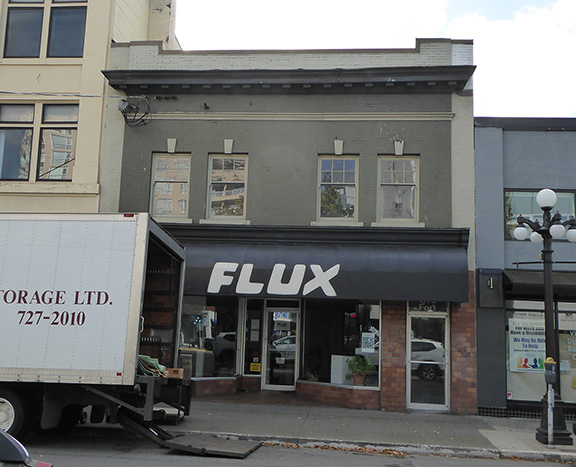Heritage Register
Fairfield
819-823 Fort Street
Turkish Bath House
Built
1908; 1913
Heritage-Designated 2019
For: G. Bergstrom Bjornfelt
Architects: Hooper & Watkins
Contractors: Luney Bros.

STATEMENT OF SIGNIFICANCE:
Description of the Historic Place
The Turkish Bath House is a two-storey commercial building situated on the south side of Fort Street, just east of downtown Victoria. This historic building is distinguishable by its pronounced cornices at the roof and storefront levels and its double-hung windows with multi-pane upper sashes and tapered keystone lintels.
Heritage Value of the Historic Place
The Turkish Bath House is significant for its association with the Edwardian-era development of Victoria and its unique purpose-built function as a Turkish Bath House and Swedish massage parlour. The building is valued additionally for its commercial architecture, as designed by the firm of Hooper & Watkins, and constructed by prolific contractors, the Luney Brothers.
Constructed during the upswing of the pre-World War One real estate boom, The Turkish Bath House is valued as part of the surge of development that characterizedVictoria's gateway economy during the Edwardian-era period. Built in 1908 and expanded in 1913, the building has been used continuously for commercial purposes, and significantly contributes to the historic character of this block of Fort Street. Originally constructed for Swede, G. Bergstrom Bjornfelt for use as his Swedish massage parlour and Turkish Bath House, this two-storey commercial structure represents the eastward expansion of Victoria's commercial core. The building was originally built as a one-storey brick Turkish Bath House, complete with state of the art facilities, for Bjornfelt, who travelled across Europe in order to research the latest technologies and equipment he would implement in his new Victoria business. The interior of the building was originally fitted with tiled floors and marble walls and was staffed entirely by Swedish attendants. Following the addition of the second storey in 1913, which Bjornfelt had planned from the beginning, intending to double the size of the facility, the building changed hands and incorporated furnished rooms on the second floor while maintaining the bath house on the ground level. The bath house function ended in 1914 and a variety of businesses subsequently occupied the building, including a cake shop, a furniture store, and a curiosity shop. The variety of commercial uses attest to the adaptability of this structure and the commercial vitality of Fort Street, one of the major thoroughfares to the eastern part of the City and the adjacent municipality of Oak Bay.
The Turkish Bath House is additionally significant for its vernacular Edwardian era architecture as designed by the architecture firm of Hooper & Watkins. The partnership was made up of Thomas Hooper (1857-1935), one of the province's most prolific architects, and C. Elwood Watkins (1875- 1942), who first entered his office as an apprentice in 1890. The firm designed many architecturally important projects that continue to define the character of Victoria, including the Victoria Public Library (1904), additions to St. Ann's Academy (1908), and many impressive residences. The firm also designed numerous projects in Vancouver including the Winch Building (1906-1909) and the Odd Fellow's Hall (1905-1906). The partnership dissolved in 1909 just following the completion of the Turkish Bath House, which had been designed in 1908. This building has additional value for its association with local contractors, the Luney Brothers. William and Walter Luney, originally from Toronto, came to Victoria in the late 1880s and established their building company in 1906. Some of the company's contracts included the CPR Terminal Building (468 Belleville Street), and the Crystal Garden (713 Douglas Street). This building exemplifies vernacular commercial Edwardian-era architectural design, and remains a valued example of the work of Hooper & Watkins and the Luney Brothers in Victoria's Old Town.
Character-Defining Elements
The key elements that define the heritage character of the Turkish Bath House include its:
• location on south side of Fort Street;
• siting on the property lines, with no setbacks;
• continuous commercial use;
• commercial form, scale and massing as expressed by its two-storey height, rectangular plan and flat roof; and full retail storefront on ground level facing Fort street;
• masonry construction;
• Edwardian-era architectural features including its simple decorative pressed metal cornices, one at the roofline featuring horizontal brackets and one above the storefront featuring corner brackets; and
• original fenestration on the second storey of the front elevation, including double-hung wood frame and sash windows featuring multipane upper sashes, wooden horns, projecting sills, and lintels with tapered rectangular keystones; as well as wood frame arched window assemblies on the rear elevation, with some sashes featuring stained and leaded glass upper sashes.
Statement of Significance by Don Luxton & Associates for City of Victoria, 2018
ADDITIONAL INFORMATION & IMAGES:
• Fairfield History
• Fairfield Heritage Register
• This Old House, Victoria's Heritage Neighbourhoods,
Volume Four: Fairfield, Gonzales & Jubilee

